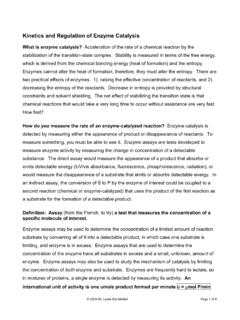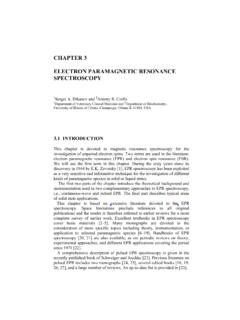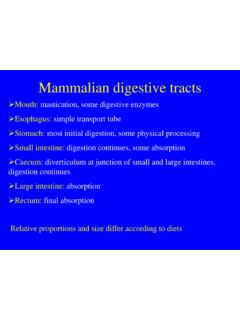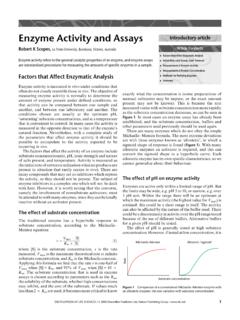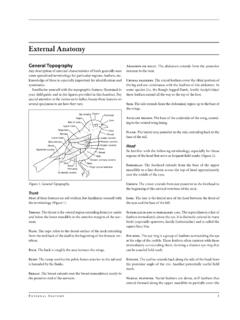Transcription of Cellular Injury, Necrosis, Apoptosis
1 Cellular Injury, Necrosis, ApoptosisCell injury results when cells are stressed and can no longer adaptInjury may progress through a reversible stage Reduced oxidative phosphorylation with resultant depletion of energy stores in the form of adenosine triphosphate (ATP) Cellular swelling caused by changes in ion concentrations and water influx Reversible Cell InjuryCell DeathNecrosis-pathologicDamage to membranes is severe, lysosomalenzymes enter the cytoplasm and digest the cell, and Cellular contents leak out Apoptosis -normal and pathologicDNA or proteins are damaged beyond repair, the cell kills itself characterized by nuclear dissolution, fragmentation of the cell without complete loss of membrane integrityAutophagy- normal and pathologicOxygen DeprivationHypoxia is a deficiency of oxygen that can result in a reduction in aerobic oxidative respiration.
2 Extremely important common cause of cell injury/cell death. Causes include reduced blood flow (ischemia), inadequate oxygenation of the blood, decreased blood oxygen-carrying AgentsMechanical trauma, extremes of temperature (burns and deep cold), sudden changes in atmospheric pressure, radiation, and electric Agents and DrugsInfectious AgentsImmunologic ReactionsGenetic DerangementsNutritional ImbalancesProtein-calorie and/or vitamin deficiencies. Nutritional excesses (overnutrition)Causes of Cell InjuryMorphology of Cell kidney tubules Epithelial cells stain evenly pink (eosinophilic) in cytoplasm, with purple, basophilic, nucleic acids confined to the nuclei Apical surfaces are ciliated Interstitia not infiltrated with immune cells nor congested with proteinsSwollen kidney tubules Increased eosinophilic staining Decreased basophilic staining (RNA) Plasma membrane rounding, blebbing, loss of cilia, due to loss of connections with cytoskeleton Integrity of tubules degrading, but basement membranes intact Nuclei largely intact, slightly narrowed, pyknoticBoudreault F , Grygorczyk R J Physiol 2004.
3 561:499-513 2004 by The Physiological SocietyHow much can a cell swell?Reversible damage Cellular swellingCellular swelling (synonyms: hydropic change, vacuolar degeneration, Cellular edema) is an acute reversible change resulting as a response to nonlethal injuries. It is an intracytoplasmic accumulation of water due to incapacity of the cells to maintain the ionic and fluid homeostasis. It is easy to be observed in parenchymal organs : liver (hepatitis, hypoxia), kidney (shock), myocardium (hypoxia, phosphate intoxication). It may be local or diffuse, affecting the whole damage fatty changeIntracellular accumulations of a variety of materials can occur in response to Cellular injury. Here is fatty metamorphosis (fatty change) of the liver in which deranged lipoprotein transport from injury (most often alcoholism) leads to accumulation of lipid in the cytoplasm of kidney tubules Cellular fragmentation Loss and fading of nuclei--karyolysis Burst membranes Loss of tissue architectureThe morphologic appearance of necrosis is the result of denaturation of intracellular proteins and enzymatic cells are unable to maintain membrane integrity and their contents often leak out, a process that may elicit inflammation in the surrounding tissue.
4 The enzymes that digest the necrotic cell are derived from the lysosomes of the dying cells themselves and from the lysosomes of leukocytesthat are called in as part of the inflammatory of Cellular contents and the host response may take hours to develop. The earliest histologic evidence of necrosis may not become apparent until 4 to 12 eosinophilia in hematoxylinand eosin (H & E) stains, attributable in part to the loss of cytoplasmic RNA (which binds the blue dye, hematoxylin) and in part to denatured cytoplasmic proteins (which bind the red dye, eosin). When enzymes have digested the cytoplasmic organelles, the cytoplasm becomes vacuolated and appears moth-eaten. Dead cells may be replaced by large, whorled phospholipid masses called myelin figures that are derived from damaged cell phospholipid precipitates are then either phagocytosed by other cells or further degraded into fatty acids; calcification of such fatty acid residues results in the generation of calcium soaps.
5 Thus, the dead cells may ultimately become changes appear in one of three patternsKaryolysis, the basophiliaof the chromatin fades which appears to reflect loss of DNA because of enzymatic degradation by due to endonucleases. Pyknosis, characterized by nuclear shrinkage and increased basophilia. Karyorrhexis, the pyknoticnucleus undergoes fragmentation. With the passage of time (a day or two), the nucleusin the necrotic cell totally large numbers of cells die the tissue or organ is said to be necroticNecrosis of tissues has several morphologically distinct patterns, which are important to recognize because they may provide clues about the underlying cause. The terms that describe these patterns are somewhat outmoded, they are used often and their implications are understood by pathologists and of Tissue Necrosis Types of Tissue necrosis Coagulative Liquefactive Gangrenous Caseous Fat FibrinoidArchitecture of dead tissues is preserved for a span of at least some exhibit a firm textureInjury denatures proteins and enzymes blocking proteolysis of the dead cells;Eosinophilic, anucleatecells may persist for days or weeks.
6 Ultimately the necrotic cells are removed by phagocytosis of the Cellular debris by infiltrating necrosis kidney infarctionThis is the typical pattern with ischemia and infarction (loss of blood supply and resultant tissue anoxia). Here, there is a wedge-shaped pale area of coagulative necrosis (infarction) in the renal cortex of the kidney. Microscopically, the renal cortex has undergone anoxic injury at the left so that the cells appear pale and ghost-like. There is a hemorrhagic zone in the middle where the cells are dying or have not quite died, and then normal renal parenchyma at the far necrosis myocardialinfarctionHere is myocardium in which the cells are dying as a result of ischemic injury from coronary artery occlusion.
7 This is early in the process of necrosis. The nuclei of the myocardial fibers are being lost. The cytoplasm is losing its structure, because no well-defined cross-striations are of the deadTransformation of the tissue into a liquid viscous necrotic material is frequently creamy yellow because of the presence of dead leukocytes and is a specific pattern. Te r m is commonly used in clinical practice. Usually applied to a limb, generally the lower leg, that has lost its blood supply and has undergone, typically, coagulativenecrosisGangrenous induced DIC has led to extensive arterial thrombosis, resulting inprofound tissue Caseous ( cheeselike) is derived from the friable white appearance of the area of necrosis Necrotic area appears as a collection of fragmented or lysed cells and amorphous granular debris enclosed within a distinctive inflammatory border.
8 This appearance is characteristic of a focus of inflammation known as a a specific patternFocal areas of fat destruction, typically resulting from release of activated pancreatic lipases into the substance of the pancreas and the peritoneal cavity. Lipases split the triglyceride esters contained within fat cells. Free fatty acids can combine with calcium to produce grossly visible chalky-white areas (fat saponification).Fat seen in immune reactions involving blood vessels. Deposits of immune complexes, together with fibrin that has leaked out of pink and amorphous appearance in H&E stains, called fibrinoid (fibrin-like) by leading to necrotic cellsEnergy depletion Inhibition of oxidative phosphorylation [ATP] decreases Small changes, 5 - 10%, are sufficient to limit the Na/K-ATPase and Ca/Mg ATPase Glycolytic capacity (glycogen stores) protects from ATP depletion but leads to acidification Plasma and ER membranes swell Enzyme kinetics change.
9 Proteins begin to denature Chromatin clumps Denatured proteins either coagulate resulting in necrosis or bind HSPs triggering , cytosolic [Ca++] as many as 4 orders of magnitude lower than extracellular or organellar(ER, SR, Mt)Mitochondrial damage and ER swelling releases Ca++ to cytosolHydrolytic enzymes activatedApoptosis may be activatedNecrosis occursCalcium FluxROS and free radicals Hydroxyl radicals and hydrogen may be split from water by ionizing radiation Superoxide radicals, hydrogen peroxide, lipid peroxides normally present in small amounts Neutralized by catalase or glutathione peroxidase ROS created and released by neutrophils in response to microbial infection Toxic chemicals natively, or after activation by P450 redox in liver or kidney.
10 May result in free radicals ROS initiate chain reaction of lipid peroxidation in of ER Programmed cell death Especially during fetal development In response to hormonal cycles ( endometrium) Normal turnover in proliferating tissues ( intestinal epithelium) Cells shrink, not swell Nuclei condense and DNA fragments Cells fragment into membrane-bound bits Bits are phagocytosed by macrophagesApoptotic fetal thymusIn this fetal thymus there is involution of thymic lymphocytes by the mechanism of Apoptosis . In this case, it is an orderly process and part of normal immune system maturation. Individual cells fragment and are consumed by phagocytes to give the appearance of clear spaces filled with Cellular debris.

